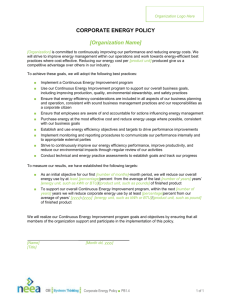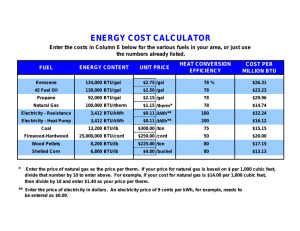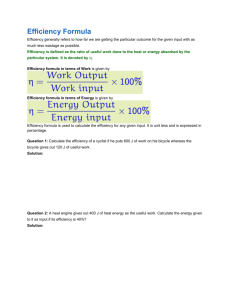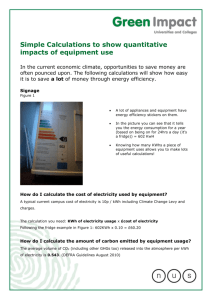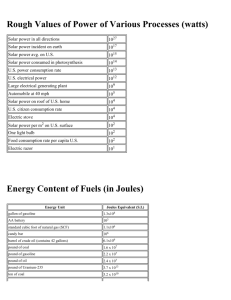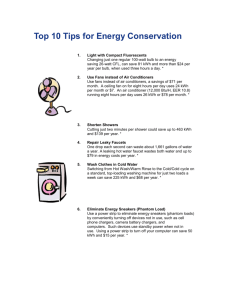AP Environmental Science: Dimensional Analysis Worksheet
advertisement
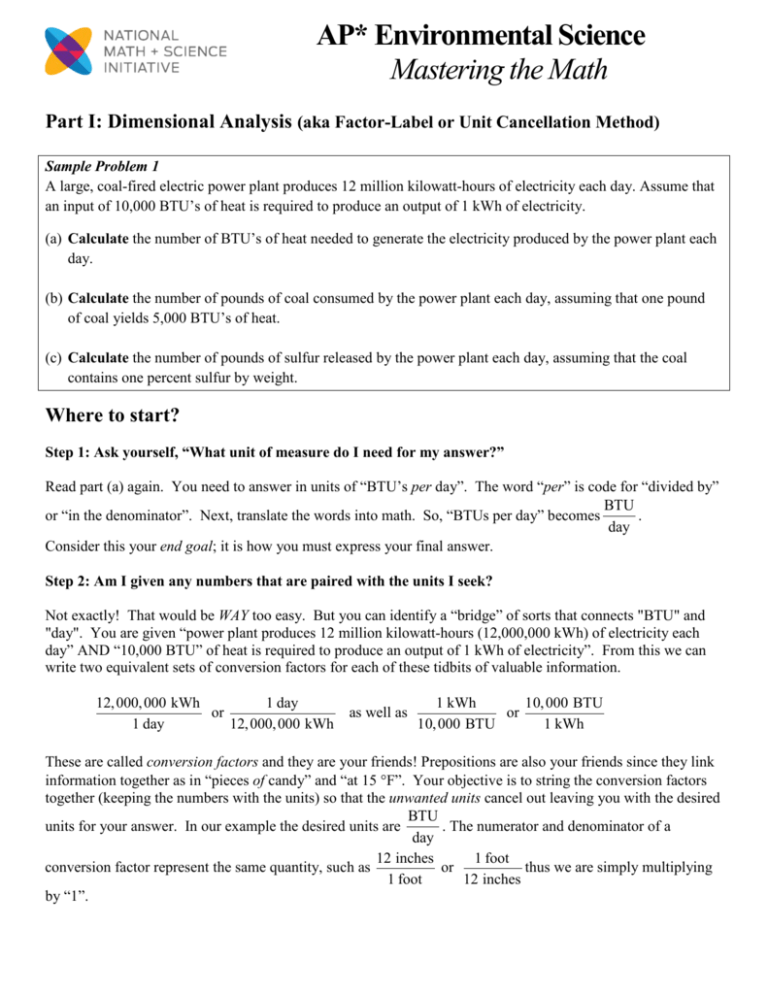
AP* Environmental Science Mastering the Math Part I: Dimensional Analysis (aka Factor-Label or Unit Cancellation Method) Sample Problem 1 A large, coal-fired electric power plant produces 12 million kilowatt-hours of electricity each day. Assume that an input of 10,000 BTU’s of heat is required to produce an output of 1 kWh of electricity. (a) Calculate the number of BTU’s of heat needed to generate the electricity produced by the power plant each day. (b) Calculate the number of pounds of coal consumed by the power plant each day, assuming that one pound of coal yields 5,000 BTU’s of heat. (c) Calculate the number of pounds of sulfur released by the power plant each day, assuming that the coal contains one percent sulfur by weight. Where to start? Step 1: Ask yourself, “What unit of measure do I need for my answer?” Read part (a) again. You need to answer in units of “BTU’s per day”. The word “per” is code for “divided by” BTU or “in the denominator”. Next, translate the words into math. So, “BTUs per day” becomes . day Consider this your end goal; it is how you must express your final answer. Step 2: Am I given any numbers that are paired with the units I seek? Not exactly! That would be WAY too easy. But you can identify a “bridge” of sorts that connects "BTU" and "day". You are given “power plant produces 12 million kilowatt-hours (12,000,000 kWh) of electricity each day” AND “10,000 BTU” of heat is required to produce an output of 1 kWh of electricity”. From this we can write two equivalent sets of conversion factors for each of these tidbits of valuable information. 12, 000, 000 kWh 1 day or 1 day 12, 000, 000 kWh as well as 1 kWh 10, 000 BTU or 10, 000 BTU 1 kWh These are called conversion factors and they are your friends! Prepositions are also your friends since they link information together as in “pieces of candy” and “at 15 °F”. Your objective is to string the conversion factors together (keeping the numbers with the units) so that the unwanted units cancel out leaving you with the desired BTU units for your answer. In our example the desired units are . The numerator and denominator of a day 12 inches 1 foot conversion factor represent the same quantity, such as thus we are simply multiplying or 1 foot 12 inches by “1”. Step 3: Choose the conversion factors AND structure them so that you achieve your “end goal”. BTU Remember we were asked to solve for “BTUs per day” which in “math speak” looks like units of . day It there is a “trick” to this process, it involves choosing conversion factors and arranging them so that the unwanted units cancel out leaving only the desired unit(s) on your final answer! For our example, you want BTU in the numerator of your final answer along with days in the denominator. So, you need to get rid of or cancel the kWh. How? BTU 12, 000, 000 kWh 10, 000 BTU and make a nice pair since they result in the desired units of . Yippee! day 1 day 1 kWh Step 4: Solve it! Let’s revisit our sample problem: When you have cancelled out the units you don't want and are left only with the units you do want, then you know it's time to multiply all the numerators (top numbers) together, and divide by EACH of the bottom numbers! When setting up a string of conversion factors, it is often helpful to start at the end (units of the desired answer) and work backwards as explained and demonstrated on the screencast. Sample Problem 1 A large, coal-fired electric power plant produces 12 million kilowatt-hours of electricity each day. Assume that an input of 10,000 BTU’s of heat is required to produce an output of 1 kWh of electricity. (a) Calculate the number of BTU’s of heat needed to generate the electricity produced by the power plant each day. 1 day × 12, 000, 000 kWh 10, 000 BTU = × 120, 000, 000, 000 BTU = 1.2 ×1011 BTU 1 day 1 kWh (b) Calculate the number of pounds of coal consumed by the power plant each day, assuming that one pound of coal yields 5,000 BTU’s of heat. (Pick up where you left off! Let the problem lead you!) 1 lb coal 120, 000, 000, 000 BTU × = 5, 000 BTU 24,000,000 lb coal or 2.4 ×107 lbs of coal (c) Calculate the number of pounds of sulfur released by the power plant each day, assuming that the coal contains one percent sulfur by weight. 24,000,000 lb coal 1 lb Sulfur 240,000 lbs of sulfur 2.4 × 105 lbs of sulfur × = or day day day 100 lb coal OR Re alize that 1.0% is equal to 0.01 in decimal form and simply multiply ∴ 0.01 × 24,000,000 lb coal 240,000 lbs of sulfur 2.4 × 105 lbs of sulfur becomes equal to or day day day 2 Sample Problem 2 The environmental impact of washing a load of dirty dishes in an electric dishwasher differs from that of washing them in a sink by hand. A comparison of the two methods may allow consumers to spend their money more wisely. Use the assumptions in the table below to perform the calculations that follow. All the dishes fit into a single load. The water entering both the water heater and the sink is at 50 °F. The water heater and the dishwasher are both 100% efficient. Washing the dishes by hand requires 20 gallons of water heated to 110 oF. In one complete cycle, the electric dishwasher uses 10 gallons of water heated to 140 oF and the dishwasher also uses 0.500 kilowatt-hour of electrical energy for its mechanical operations. (a) A British thermal unit or BTU is the amount of energy needed to raise the temperature of one pound of water 1.0 °F. Additionally, one gallon of water has a mass of 8.0 pounds. Calculate the total energy used to wash a load of dishes using the dishwasher. (b) One kilowatt-hour is equivalent to 3,400 BTUs and the cost of electricity is $0.11 per kWh. Calculate the energy in BTU used to heat the water for washing a load of dishes by hand. (c) Calculate the cost of electricity for each dishwashing method given that one kilowatt-hour is equivalent to 3,400 BTUs and the cost of electricity is $0.11 per kWh. Step 1: Ask yourself, “What unit of measure do I need for my answer?” Read part (a) again. The question asks you to calculate “total energy” per load, so you need to answer in units BTU of “BTU per load”. Translate that to math and you get or simply BTU. Consider this your end goal; it is load how you must express your final answer for parts (a). Next, read part (b) again. The final answer to part (b) BTU should also be reported in or simply BTU. load Step 2: Am I given any numbers that are paired with the units I seek? Yes! (Remember, it is a legal maneuver to “flip” any of these conversion factors as long as you keep the appropriate number with the appropriate unit!) 10 gal H 2 O 1 gal H 2 O 1 BTU and and and note the temperature change! load 1 lb H 2 O • 1 °F 8 lb H 2 O Yep! That’s TWO items in the denominator of one of the conversion factors, thus twice the cancelling fun. Step 3: Choose the conversion factors AND structure them so that you achieve your “end goal”. Ask yourself “What to flip and why flip at all?” Step 4: Solve it! 3 Sample Problem 2 The environmental impact of washing a load of dirty dishes in an electric dishwasher differs from that of washing them in a sink by hand. A comparison of the two methods may allow consumers to spend their money more wisely. Use the assumptions in the table below to perform the calculations that follow. All the dishes fit into a single load. The water entering both the water heater and the sink is at 50 °F. The water heater and the dishwasher are both 100% efficient. Washing the dishes by hand requires 20 gallons of water heated to 110 oF. In one complete cycle, the electric dishwasher uses 10 gallons of water heated to 140 oF and the dishwasher also uses 0.500 kilowatt-hour of electrical energy for its mechanical operations. (a) A British thermal unit or BTU is the amount of energy needed to raise the temperature of one pound of water 1.0 °F. Additionally, one gallon of water has a mass of 8.0 pounds. Calculate the total energy used to wash a load of dishes using the dishwasher. Start with the temperature change! Why? It has an understood denominator of “1” which doesn’t need cancelling out. 90 °F × 10 gal H 2 O 8 lb H 2 O BTU 1 BTU × × = 7, 200 load load 1 lb H 2 O • 1 °F 1gal H 2 O (b) Calculate the energy in BTU used to heat the water for washing a load of dishes by hand. 60 °F × 20 gal H 2 O 8 lb H 2 O 1 BTU BTU × × = 9, 600 load load 1 lb H 2 O • 1 °F 1gal H 2 O (c) Calculate the cost of electricity for each dishwashing method given that one kilowatt-hour is equivalent to 3,400 BTUs and the cost of electricity is $0.11 per kWh. Dishwasher: 7, 200 Sink: 9, 600 $0.11 1 kWh BTU = $0.23 or 23 cents × × load 3, 400 BTU kWh 1 kWh $0.11 BTU × = $0.31 or 31 cents × load 3, 400 BTU kWh Surprising? Remember, these problems ignore the price of the water! 4 Part 2: Determining Energy Efficiency Energy efficiency is simply the ratio of work output to work input. If the problem states that system is less than 100 % efficient, then the energy output must be divided by the stated efficiency to determine how much energy input is needed. Work out Percent Efficiency = × 100% Work in Our previous sample problem made this easy on us by telling us the efficiency is 100%. Don’t always expect that since such machines do not exist! If a machine or process is 75% efficient then you simply multiply anything you calculate as being “perfect” by 0.75 effectively reducing it to only 75% rather than leaving it at the elusive 100% efficiency. Sample Problem 3 Answer the questions below regarding the heating of a house in the Midwestern United States. Use the assumptions in the table below to perform the calculations that follow. The house has 2,000 square feet of living space. 80,000 BTUs of heat per square foot are required to heat the house for the winter. Natural gas is available at a cost of $5.00 per thousand cubic feet. One cubic foot of natural gas supplies 1,000 BTUs of heat energy. The furnace in the house is 80 percent efficient. (a) Calculate number of cubic feet of natural gas required to heat the house for one winter. Show all the steps of your calculations, including units. 2.0 ×103 ft 2 × 8.0 ×104 BTU ft 2 × 1ft 3 16 ×107 3 1.6 ×108 3 = ft = 3 ft = 1.6 ×10(8−3) ft 3 = 1.6 ×105 ft 3 3 3 1×10 1×10 1×10 BTU But wait! That’s only if the process is 100% efficient. Since the process is only 80% efficient it will require more natural gas to heat the house. So, divide your “perfect” answer by the efficiency expressed as a decimal value, 0.80 in our case. 1.6 1.6 ×105 ft 3 ÷ 0.80 = ×105 ft 3 = 2 ×105 ft 3 or 200,000 ft 3 if you prefer 0.8 (b) Calculate the cost of heating the house for one winter. 2 ×105 ft 3 × $5.00 3 10 ft 3 = $10 ×10(5−3) = $10 ×102 = $1, 000 5 Part 3: Scientific Notation Scientific notation is used to communicate extremely large numbers such as the speed of light or extremely small numbers such as the radius of a blood cell. 1. Converting decimal numbers LESS THAN ONE to Scientific Notation Example: Express the number 0.00234 in scientific notation. • Place a decimal after the first nonzero number. We refer to this as the coefficient. Coefficients need to be between 1 and 9. The coefficient is then multiplied by ten raised to an exponent, 10exponent • Determine the exponent on the “10” by counting the number of places you move the decimal point. If you move the decimal to the right, the exponent will be negative. If you move the decimal point to the left, the exponent will be positive. Negative exponents tell us how many times the number has been divided by 10 Positive exponents tell us how many times the number has been multiplied by 10 So, to express the number 0.00234 in scientific notation, we move the decimal 3 places to the right: 0.00234 to give 2.34 × 10-3 What does this really mean mathematically? 2.34 2.34 2.34 or or or 2.34 × 10−3 3 10 10 ×10 ×10 1, 000 Essentially, it means the number is small. How small? In the thousandths. Why do this? For years you’ve thought 0.00234 was a perfectly good number just the way it is. Why convert it to scientific notation? BECAUSE it allows us to focus on the “order of magnitude” of measurements or quantities rather than the coefficients. Compare 2.34 × 10−3 to 2.34 × 103 It’s not that the 2.34 is the most important part of the number—it’s that the number is in the thousandths (10−3) versus the thousands (103). So, 2.34 × 103 is SIX power of ten’s (10 × 10 × 10 × 10 × 10 × 10), that’s 106, or a million times larger! We say that 2.34 × 103 is six orders of magnitude greater than 2.34 × 10−3 2. Nuances of Adding and Subtracting Numbers Written in Scientific Notation First, make sure both numbers have the same exponent on the “× 10” part. It’s easiest to convert one number to the greater exponent: 0.52 × 104 5.2 × 103 + 3.6 × 104 becomes 0.52 × 104 + 3.6 × 104 or, you may prefer it stacked + 3.6 × 104 4.12 × 104 Either way, (0.52 + 3.6) × 104 becomes 4.12 × 104 All done! Subtraction works the same way. 6 3. Nuances of Multiplying Numbers Written in Scientific Notation: This is much easier! Simply, multiply the coefficients and then add the exponents on the power of 10. (4 × 10−2) × (2 × 1010) = (4 × 2) × 10(−2 + 10) becomes 8 × 10(−2 + 10) which simplifies to 8 × 108 Division works the same way EXCEPT you subtract the exponents on the power of 10. (4 × 10−2) ÷ (2 × 1010) = (4 ÷ 2) × 10(−2 − 10) becomes 2 × 10(−2 − 10) which simplifies to 2 × 10−12 Sample Problem 4 Calculate the potential reduction in petroleum consumption in gallons of gasoline per year that could be achieved in the United States by introducing electric vehicles under the following assumptions: • • • • The mileage rate for the average car is 25 miles per gallon of gasoline. The average car is driven 10,000 miles per year. The United States has 150 million cars. Ten percent of the US cars could be replaced with electric cars. Start with the easy simplification & translate the numbers into scientific notation: 10% of 150 million cars = 15 million cars = 1.5 × 107 cars… now on to the dimensional analysis… 1×104 mi 1 gal 1.5 ×1011 gal 150 gal gal then simplify to 1.5 ×10 cars × × = ×109 = 6 ×109 25 year 25 year year car • year 25 mi 7 Part 4: Population Growth Rate Demography is the study of the characteristics of human populations, such as size, growth, density, distribution, and other vital statistics. In demography, population growth is used informally for the more specific term population growth rate (PGR), and is often used to refer specifically to the growth of the human population of the world. The most common way to express population growth is as a percentage, not as a rate. First, we calculate the change in a population using the difference between the crude birth and death rates. What are those? The crude birth rate (CBR) is the total number of births per year per 1,000 people and the crude death rate (CDR) is the total number of deaths per year per 1,000 people. In the formula below we simply divide by ten to report the PGR as a percentage. (We wouldn’t need to divide by 10 if the CBR & CDR were expressed per “100” instead of per 1,000.) CBR − CDR PGR (as a percentage) = 10 7 Part 5: The Rule of 70 The Rule of 70 is used to calculate the time required for a doubling of a population based upon population growth rate, PGR, expressed as a percentage. Resist the urge to express the growth percentage as a decimal value, leave it as a percentage! The Rule of 70 is mathematically expressed as: timedoubling = 70 PGR (expressed as a percentage) How long will it take for a city with an annual population growth rate of 5% to double its population? timedoubling = 70 70 = = 14 years PGR (expressed as a percentage) 5% How long will it take for the same city if the growth rate were 7%? timedoubling = 70 70 = = 10 years PGR (expressed as a percentage) 7% Sample Problem 5 The fictional country Industria is tracking its population data. In 1855, the first year vital statistics were reported for the country, the population was 1.6 million, with a crude birth rate of 43 per 1,000. At that time the population of Industria was growing quite slowly, because of the high death rate of 41 per 1,000. In 1875 the population began to grow very rapidly as the birth rate remained at the 1855 level. While the crude death rate dropped dramatically to 20 per 1,000. Population growth continued to increase in the small country into the late 1800’s, even though birth rates began to decline slowly. In 1895 the crude birth rate had dropped to 37, and the crude death rate to 12 per 1,000. A complete census was also conducted and revealed that the population of Industria had grown to 2.5 million. By 1950 population growth gradually began to decline as the death rate remained at its 1895 level, while the birth rate continued to decline to 22 per 1,000. In 1977 vital statistics revealed that the death rate was 10 per 1,000, and that population growth had slowed even more to an annual rate of 0.4%. By 1990 Industria had reduced its birth rate to that of its now constant, low death rate, and the population transition was complete. (a) Calculate the annual growth rate of Industria in 1950. CBR − CDR 22 − 12 Annual PGR (as a percentage) = = = 1% 10 10 (b) Calculate the birth rate in Industria in 1977. In 1977 CDR was 10 and the PGR was 0.4% . So, solve for CBR: PGR = CBR − CDR CBR − 10 ∴ 0.4% = ∴= 4 CBR − 10 ∴ CBR = 14 10 10 continued on next page 8 (c) Assume the population of Industria continues to maintain the population growth rate recorded for the country in 1895. Determine the year in which the expected size of the population will have quadrupled. First, calculate the PGR for 1895: PGR1895 = CBR − CDR 37 − 12 25 = = = 2.5% 10 10 10 Next, use the Rule of 70 to determine the number of years it takes the population to double: timedoubling = 70 70 = = 28 years PGR (expressed as a percentage) 2.5% Finally, realize that a quadrupling is 2 doublings, so 56 years have passed by the time the size of the population has doubled. So, 1895 + 56 additional years = 1951 (Harry S. Truman was president, I Love Lucy made its TV debut, and the Korean War was taking place.) Part 6: Per Capita Per Capita is a Latin term that translates into "by head," basically meaning "average per person." Per capita can even the place of saying "per person" in any number of statistical observances. In most cases the term is used in relation to economic data or reporting, but can also be used in most any other occurrence of population description. Sample Problem 6 Between 1950 and 2000, global meat production increased from 52 billion kilograms to 240 billion kilograms. During this period, the global human population increased from 2.6 billion to 6.0 billion. (a) Calculate the per capita meat production in 1950 and in 2000. For 1950: For 2000: 52 ×109 kg 52 ×109 kg = 8 = 2 ×10(9−8) kg = 2 ×101 kg = 20 kg per capita 9 2.6 ×10 26 ×10 240 ×109 kg 6 ×109 = 40 kg per capita (b) Calculate the change in global per capita meat production during this 50-year period. Express your answer as a percentage. No calculation necessary! Since the consumption per capita doubled, that translates to a 100% increase. 9 Sample Problem 7 West Fremont is a community consisting of 3,000 homes. A small coal-burning power plant currently supplies electricity for the town. The capacity of the power plant is 12 megawatts (MW) and the average household consumes 8,000 kilowatt hours (kWh) of electrical energy each year. The price paid to the electric utility by West Fremont residents for the energy is $0.10 per kWh. The town leaders are considering a plan, the West Fremont Wind Project (WFWP), to generate their own electricity using 10 wind turbines that would be located on the wooded ridges surrounding the town. Each wind turbine would have a capacity of 1.2 MW and each would cost the town $3 million to purchase, finance, and operate for 25 years. (a) Assuming that the existing power plant can operate at full capacity for 8,000 hrs/yr, how many kWh of electricity can be produced by the plant in a year? 8, 000 hr kWh ×12 ×103 kW = 9.6 ×107 yr yr (b) At the current rate of electricity energy per household, how many kWh of energy does the community consume in one year? 8, 000 kWh kWh kWh 3, 000 homes × = 24, 000, 000 or 2.4 ×107 yr yr yr (c) Assuming that the electrical energy needs of the community do not change during the 25-year lifetime of the wind turbines, what would be the cost to the community of the electricity supplied by the WFWP over 25 years? Express your answer in dollars/kWh. TWO DIFFERENT METHODS earn full credit: (surprising since the costs are very different!) kWh $3 ×106 8 = $3 ×107 2.4 ×10 × 25 yrs = 6.0 ×10 kWh and 10 turbines × yr turbines 7 ∴ Cost is $3 ×107 $3 ×107 $3 $ 0.05 = = = 8 7 6.0 ×10 kWh 60 × ×10 kWh 60 kWh OR 9.6 ×107 kWh × 25 yrs = 2.4 ×109 kWh yr ∴ Cost is $3 ×107 $3 ×107 $3 $ 0.0125 = = = 9 9 2.4 ×10 kWh 2.4 ×10 kWh 240 kWh 10 Sample Problem 8 The Cobb family of Fremont is looking at ways to decrease their home water and energy usage. Their current electric hot-water heater raises the water temperature to 140o F, which requires 0.20 kWh/gallon at a cost of $0.10/kWh. Each person in the family of four showers once a day for an average of 10 minutes per shower. The shower has a flow rate of 5.0 gallons per minute. (a) Calculate the total amount of water that the family uses per year for taking showers. 4 people × 365 days yr × 1 shower 10 min 5 gal gal × × = 73, 000 yr person • day shower min (b) Calculate the annual cost of the electricity for the family showers, assuming that 2.5 gallons per minute of the water used is from the hot-water heater. So, they are telling us that ½ of the total water used in each shower is water heated by the hot water heater. gal Fair enough! Simply start this cost analysis using ½ (73,000) = 36,500 . So, yr 36,500 gal 0.20 kWh $ 0.10 $36,500 × (0.20 × 0.10) $ 730 = × × = yr yr yr gal kWh (c) The family is considering replacing their current hot-water heater with a new energy-efficient hot-water heater that costs $1,000 and uses half the energy that their current hot-water heater uses. How many days would it take for the new hot-water heater to recover the $1,000 initial cost? $ 730 $2 $1 = Cost of OLD: versus Cost of NEW: Half as much ∴ 365 days day day So, the family is saving a $1 a day, thus it will take 1,000 days to save $1,000 which recoups their original investment! 11
